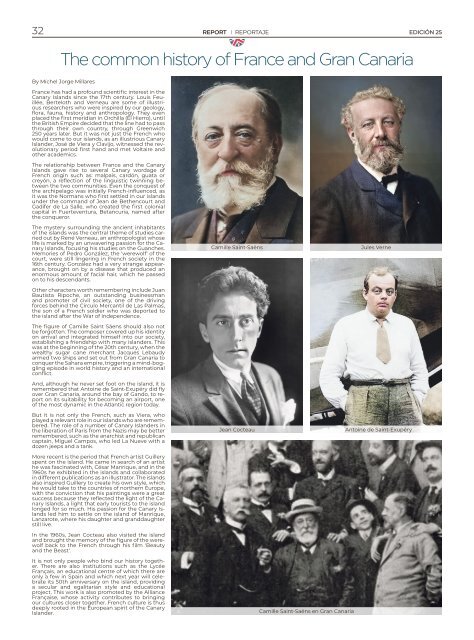No. 25 - Its Gran Canaria Magazine
Rutas, recomendaciones y noticias de Gran Canaria. Routes, tips and news about Gran Canaria.
Rutas, recomendaciones y noticias de Gran Canaria.
Routes, tips and news about Gran Canaria.
Create successful ePaper yourself
Turn your PDF publications into a flip-book with our unique Google optimized e-Paper software.
32<br />
REPORT I REPORTAJE EDICIÓN <strong>25</strong><br />
The common history of France and <strong>Gran</strong> <strong>Canaria</strong><br />
By Míchel Jorge Millares<br />
France has had a profound scientific interest in the<br />
Canary Islands since the 17th century. Louis Feuillée,<br />
Berteloth and Verneau are some of illustrious<br />
researchers who were inspired by our geology,<br />
flora, fauna, history and anthropology. They even<br />
placed the first meridian in Orchilla (El Hierro), until<br />
the British Empire decided that the line had to pass<br />
through their own country, through Greenwich<br />
<strong>25</strong>0 years later. But it was not just the French who<br />
would come to our islands, as an illustrious Canary<br />
Islander, José de Viera y Clavijo, witnessed the revolutionary<br />
period first hand and met Voltaire and<br />
other academics.<br />
The relationship between France and the Canary<br />
Islands gave rise to several Canary wordage of<br />
French origin such as: malpaís, cardón, guata or<br />
creyón, a reflection of the linguistic twinning between<br />
the two communities. Even the conquest of<br />
the archipelago was initially French-influenced, as<br />
it was the <strong>No</strong>rmans who first settled in our islands<br />
under the command of Jean de Bethencourt and<br />
Gadifer de La Salle, who created the first colonial<br />
capital in Fuerteventura, Betancuria, named after<br />
the conqueror.<br />
The mystery surrounding the ancient inhabitants<br />
of the islands was the central theme of studies carried<br />
out by René Verneau, an anthropologist whose<br />
life is marked by an unwavering passion for the Canary<br />
Islands, focusing his studies on the Guanches.<br />
Memories of Pedro González, the 'werewolf' of the<br />
court, were still lingering in French society in the<br />
16th century. González had a very strange appearance,<br />
brought on by a disease that produced an<br />
enormous amount of facial hair, which he passed<br />
on to his descendants.<br />
Other characters worth remembering include Juan<br />
Bautista Ripoche, an outstanding businessman<br />
and promoter of civil society, one of the driving<br />
forces behind the Círculo Mercantil de Las Palmas,<br />
the son of a French soldier who was deported to<br />
the island after the War of Independence.<br />
The figure of Camille Saint Säens should also not<br />
be forgotten. The composer covered up his identity<br />
on arrival and integrated himself into our society,<br />
establishing a friendship with many islanders. This<br />
was at the beginning of the 20th century, when the<br />
wealthy sugar cane merchant Jacques Lebaudy<br />
armed two ships and set out from <strong>Gran</strong> <strong>Canaria</strong> to<br />
conquer the Sahara empire, triggering a mind-boggling<br />
episode in world history and an international<br />
conflict.<br />
And, although he never set foot on the island, it is<br />
remembered that Antoine de Saint-Exupéry did fly<br />
over <strong>Gran</strong> <strong>Canaria</strong>, around the bay of Gando, to report<br />
on its suitability for becoming an airport, one<br />
of the most dynamic in the Atlantic region today.<br />
But it is not only the French, such as Viera, who<br />
played a relevant role in our islands who are remembered.<br />
The role of a number of Canary Islanders in<br />
the liberation of Paris from the Nazis may be better<br />
remembered, such as the anarchist and republican<br />
captain, Miguel Campos, who led La Nueve with a<br />
dozen jeeps and a tank.<br />
More recent is the period that French artist Guillery<br />
spent on the island. He came in search of an artist<br />
he was fascinated with, César Manrique, and in the<br />
1960s he exhibited in the islands and collaborated<br />
in different publications as an illustrator. The islands<br />
also inspired Guillery to create his own style, which<br />
he would take to the countries of northern Europe,<br />
with the conviction that his paintings were a great<br />
success because they reflected the light of the Canary<br />
Islands, a light that early tourists to the island<br />
longed for so much. His passion for the Canary Islands<br />
led him to settle on the island of Manrique,<br />
Lanzarote, where his daughter and granddaughter<br />
still live.<br />
In the 1960s, Jean Cocteau also visited the island<br />
and brought the memory of the figure of the werewolf<br />
back to the French through his film 'Beauty<br />
and the Beast'.<br />
Camille Saint-Saëns<br />
Jean Cocteau<br />
Jules Verne<br />
Antoine de Saint-Exupéry<br />
It is not only people who bind our history together.<br />
There are also institutions such as the Lycée<br />
Français, an educational centre of which there are<br />
only a few in Spain and which next year will celebrate<br />
its 50th anniversary on the island, providing<br />
a secular and egalitarian style and educational<br />
project. This work is also promoted by the Alliance<br />
Française, whose activity contributes to bringing<br />
our cultures closer together. French culture is thus<br />
deeply rooted in the European spirit of the Canary<br />
Islander.<br />
Camille Saint-Saëns en <strong>Gran</strong> <strong>Canaria</strong>















